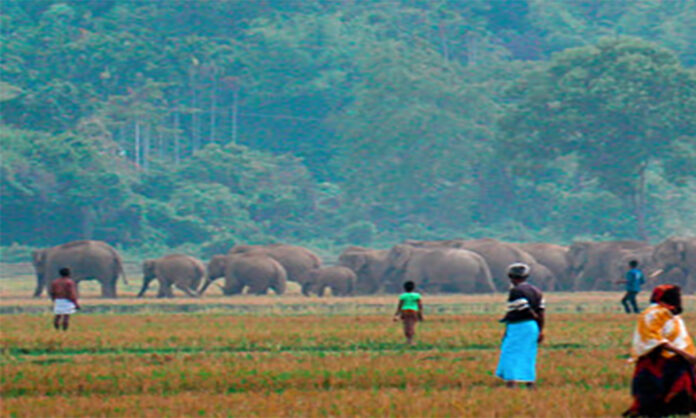
The bordering area spreading from Balijuri, Sherpur to Gobindapur, Netrokona is a hotbed of human-elephant conflict. Wild Asian elephants, a critically endangered species, are trapped within the geopolitical boundaries of India and Bangladesh.
Immediately below the Meghalaya Hills, India, are the districts of Sherpur, Mymensingh, and Netrokona from northern Bangladesh. Since time immemorial, the region has belonged to elephants. They usually forage on the undulating, stream-fed lands of Balijuri, Nalkura, Madhutila, Haluaghata, Dhobaura, and Susang Durgapur. The agroforest landscape interspersed with hillocks and deciduous forests, rivulets, and streams attract the elephants.
While on my visit to northern Bangladesh in 1994, I observed the movement of elephants twice a year. Back then, conflict was unheard of. During harvest season, these majestic creatures used to perform their seasonal trekking. They used to stay for two or three weeks and leave without causing any harm.
But since the last decade, the elephants have been staying for months. And the conflict has started intensifying. I looked into the timeline of the conflict, and a certain pattern became evident.
Since 2003–04, the hill forests in northern Bangladesh have been going through massive changes. The whole landscape is now used for agriculture throughout the year. There are paddy fields and jackfruit, mango, and pineapple orchards. There are Acacia woodlots. At the same time, the population is multiplying rapidly. Development has crept in and the boon of profits can be felt.
In northern Bangladesh, we have gradually lost all sorts of wildlife. However, like all human-domineering acts that impacted nature, challenges follow the pursuits; elephants have opted to put a serious claim to their ancestral lands, unlike leopards, clouded leopards, and dholes, that have been long left the region in silence, in negligence.
Enticed by easily accessible and abundant food, elephants have developed a liking to roaming northern Bangladesh and feeding on the paddy harvests and the orchard produce. It often goes for six months at a stretch. Until the last decade, the events were somewhat peaceful. It worsened when the border fences were erected on the Indian side.
Although the fences have been built with openings for some wildlife crossing points, I observed elephants facing difficulties to find the correct crossing. They used to descend from Meghalaya through these crossing points, only to get back after an extended stay. They also used streams for border-crossing. Everything had carried on without any bloodshed. In 2019, the relationship with humans took a steep downhill turn. The border-crossing gates were kept shut. The fences block all streams and runnels. Furthermore, whenever elephants try to cross the fence, they are now shooed away and pushed back inside Bangladesh.
As a result, the elephants are now stuck in northern Bangladesh. Tragically, the region does not have enough forested landscape anymore to provide sufficient food. Elephants have grown dependent on the harvest and the orchards. In 2015, I saw over 100 elephants. In the last seven years, many were killed by the locals. Many human casualties also took place. Currently, the elephants in the region form two herds that often forage together.
In the last week of May this year, I visited Vabanipur village of Susang Durgapur, Netrokona. I was informed that elephants had been there for a while. By the time I had reached, the herd moved west, stationing at North Ranipur village of Dhobaura subdistrict, Mymensingh. I followed.
It was noon when I reached the place. The elephants were on a hillock, resting under the few remaining shal trees. I noticed them trekking down from the height to the small pools to quench their thirst. Often, they tried to munch on bamboo shoots and leaves.
I also observed several curious onlookers on another hillock. It was a safe distance. After a while, a few Forest Department personnel arrived at the place, briefed the locals about the potential danger and not to go dangerously close to the elephants. Since November 2021, after several elephants were killed by locals, the field staff of the Forest Department have ramped up patrols. I also noticed some border guard forces too. They left shortly after assessing the situation.
Suddenly, it started raining. My team and I took shelter in a nearby village hut. The house owner was friendly and understood our intentions. He pointed out a challenging issue impeding human-elephant coexistence. Every afternoon, thousands of onlookers gather to see the elephants. This ends up annoying the animals.
I found his remarks to be true. The rain stopped by 5pm in the afternoon. Soon, I saw a huge gathering of onlookers who had arrived at the place on foot and on vehicles. They completely encircled the peaceful elephants. Many went straight for the hillock; the elephants were cornered by then at the top of it. Many tried to ascend the hillock as well and the elephants began chasing them away. After half an hour, the elephants, feeling unsafe, left the hillock, stampeding through a paddy field. Then all hell broke loose.







